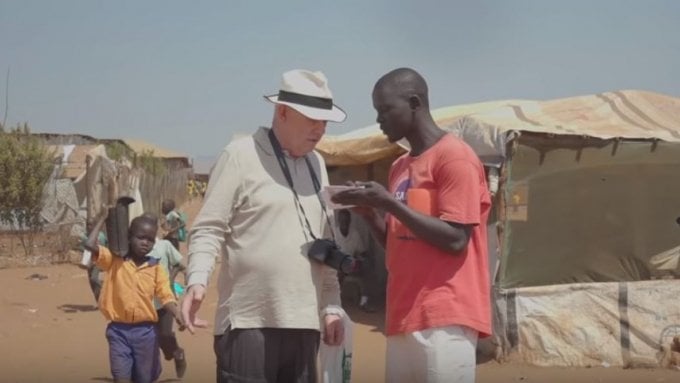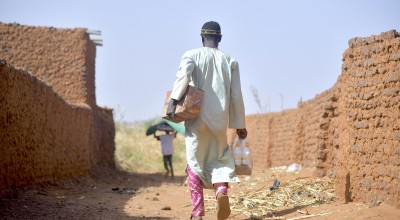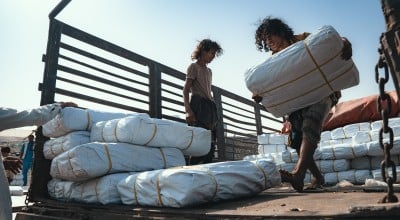
Read our 2024 annual report

Knowledge Hub
Using art to provoke action at the UN

As Irish artist Brian Maguire's 'War Changes Its Address' exhibition is unveiled at the UN, Concern Worldwide Chief Executive Dominic MacSorley reflects on the close connection between art and activism
In the same week that air attacks in north east Syria forced the largest displacement of civilians since war began, Irish artist and activist Brian Maguire’s Aleppo paintings were unveiled right in the heart of UN HQ in New York.
At the opening of the exhibition ‘War Changes Its Address’, Ambassador Geraldine Byrne Nason described the Aleppo paintings as a visceral reminder of the human consequences of conflict and “the provocation that we need in this house”.
Today, where we are subjected to an oversaturation of news, human tragedy is crowded out. The more horror there is in the world, the more it turns into a statistic for those not actually present. So, whether it is through art, protest or public pressure, this provocation is needed.
And Maguire is fully qualified to provoke.
Whether it is in Mexican prisons, Aleppo or Bentiu in South Sudan, the vast city of plastic sheeting for 120,000 internally displaced where Concern is working, Brian’s task in his painting is to make the invisible visible and make the suffering relatable so that people far removed cannot ignore or overlook it.
He doesn’t pretend to embody his subject’s viewpoint, but he also doesn’t stand apart from it. He is a translator and an agitator. A man of few words, Maguire generally lets the paintings speak for themselves but did add this simple but powerful plea: “I got to see the rubble that the world created. We need to find a new way to get to conflict resolution before we make rubble of people’s homes and lives.”
Pablo Picasso’s Guernica expresses the horrors of war in a way that no verbal communication ever could but Maguire’s paintings are not just mere catalogues of tragedy - they could only have been made with a compassionate and considerate eye.
Even among the horror, you get the sense that he wants us to believe that there is hope in the worst of circumstances. Among the rubble of Aleppo, there are shoots of grass pushing through. Against the backdrop of black and white plastic sheeting in the Bentiu camp, you see a young child in a red dress playing.
As difficult as these paintings are, there is a humanity and a suggestion that there are alternatives to what they depict and that such things are not inevitable.
However, art cannot just provoke emotion or thought when its subject is so raw that it should promote action and reaction.
Next month, Syria will enter its 10th year of conflict. The war is estimated to have left more than half a million dead and almost 11.7 million people in need of humanitarian assistance.
As hundreds of thousands are again forced to flee (and not once, but twice), UN Emergency Relief Coordinator Mark Lowcock has said that calamity can only be avoided if the Security Council members and those with influence overcome individual interests and put a collective stake in humanity first.
This is why it is so important to have the destroyed streets of Aleppo represented at the UN - the crossroads of the world. It is a stark reminder to all nations, and in particular to the Security Council, that it needs to go back to what it was set up to do 75 years ago. That is, to utilize its collective resources, energy and creativity to prevent conflict, not just manage and, in some cases, prolong it.
Watch Brian Maguire's visit to Bentiu in South Sudan with Concern Worldwide
Other ways to help
Corporate support
Is your company interested in working together for a common cause?
Fundraise for Concern
From mountain trekking to marathon running, cake sales to table quizzes, there are lots of ways you can support our work.
Buy a gift
With an extensive range of alternative gifts, we have something to suit everybody.
Leave a gift in your will
Leave the world a better place with a life-changing legacy.
Volunteer with Concern
The lots of ways to get involved with our work as a volunteer
School fundraising
Without the generous support from schools, we wouldn't be able to do the work that we do.





